1. 阅读理解之细节理解题
- 格式:ppt
- 大小:170.00 KB
- 文档页数:5
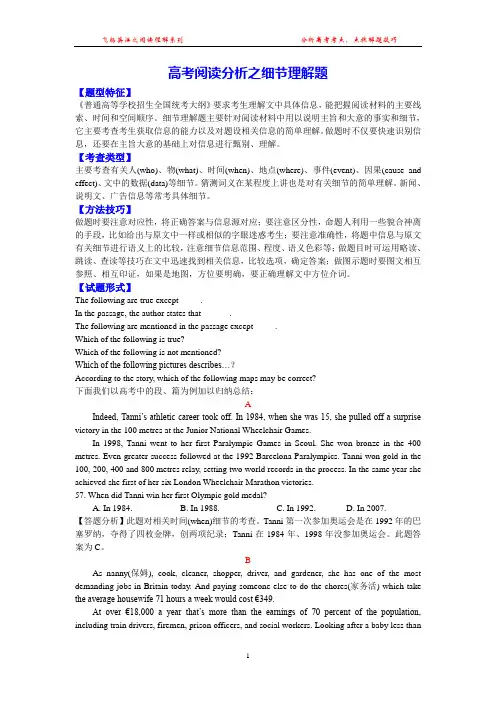
高考阅读分析之细节理解题【题型特征】《普通高等学校招生全国统考大纲》要求考生理解文中具体信息,能把握阅读材料的主要线索、时间和空间顺序。
细节理解题主要针对阅读材料中用以说明主旨和大意的事实和细节,它主要考查考生获取信息的能力以及对题设相关信息的简单理解。
做题时不仅要快速识别信息,还要在主旨大意的基础上对信息进行甄别、理解。
【考查类型】主要考查有关人(who)、物(what)、时间(when)、地点(where)、事件(event)、因果(cause and effect)、文中的数据(data)等细节。
猜测词义在某程度上讲也是对有关细节的简单理解。
新闻、说明文、广告信息等常考具体细节。
【方法技巧】做题时要注意对应性,将正确答案与信息源对应;要注意区分性,命题人利用一些貌合神离的手段,比如给出与原文中一样或相似的字眼迷惑考生;要注意准确性,将题中信息与原文有关细节进行语义上的比较,注意细节信息范围、程度、语义色彩等;做题目时可运用略读、跳读、查读等技巧在文中迅速找到相关信息,比较选项,确定答案;做图示题时要图文相互参照、相互印证,如果是地图,方位要明确,要正确理解文中方位介词。
【试题形式】The following are true except_____.In the passage, the author states that ______.The following are mentioned in the passage except_____.Which of the following is true?Which of the following is not mentioned?Which of the following pictures describes…?According to the story, which of the following maps may be correct?下面我们以高考中的段、篇为例加以归纳总结:AIndeed, Tanni’s athletic career took off. In 1984, when she was 15, she pulled off a surprise victory in the 100 metres at the Junior National Wheelchair Games.In 1998, Tanni went to her first Paralympic Games in Seoul. She won bronze in the 400 metres. Even greater success followed at the 1992 Barcelona Paralympics. Tanni won gold in the 100, 200, 400 and 800 metres relay, setting two world records in the process. In the same year she achieved she first of her six London Wheelchair Marathon victories.57. When did Tanni win her first Olympic gold medal?A. In 1984.B. In 1988.C. In 1992.D. In 2007.【答题分析】此题对相关时间(when)细节的考查。
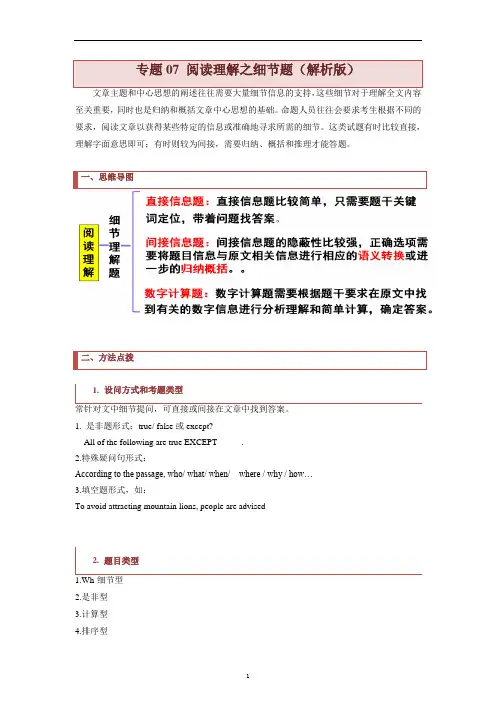
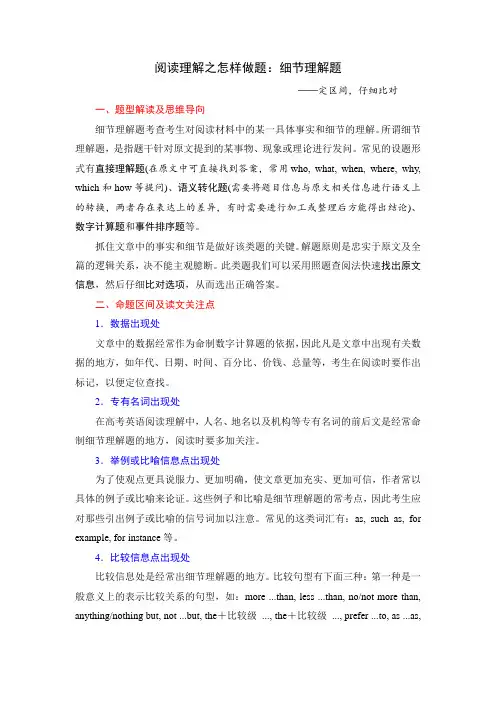
阅读理解之怎样做题:细节理解题——定区间,仔细比对一、题型解读及思维导向细节理解题考查考生对阅读材料中的某一具体事实和细节的理解。
所谓细节理解题,是指题干针对原文提到的某事物、现象或理论进行发问。
常见的设题形式有直接理解题(在原文中可直接找到答案,常用who, what, when, where, why, which和how等提问)、语义转化题(需要将题目信息与原文相关信息进行语义上的转换,两者存在表达上的差异,有时需要进行加工或整理后方能得出结论)、数字计算题和事件排序题等。
抓住文章中的事实和细节是做好该类题的关键。
解题原则是忠实于原文及全篇的逻辑关系,决不能主观臆断。
此类题我们可以采用照题查阅法快速找出原文信息,然后仔细比对选项,从而选出正确答案。
二、命题区间及读文关注点1.数据出现处文章中的数据经常作为命制数字计算题的依据,因此凡是文章中出现有关数据的地方,如年代、日期、时间、百分比、价钱、总量等,考生在阅读时要作出标记,以便定位查找。
2.专有名词出现处在高考英语阅读理解中,人名、地名以及机构等专有名词的前后文是经常命制细节理解题的地方,阅读时要多加关注。
3.举例或比喻信息点出现处为了使观点更具说服力、更加明确,使文章更加充实、更加可信,作者常以具体的例子或比喻来论证。
这些例子和比喻是细节理解题的常考点,因此考生应对那些引出例子或比喻的信号词加以注意。
常见的这类词汇有:as, such as, for example, for instance等。
4.比较信息点出现处比较信息处是经常出细节理解题的地方。
比较句型有下面三种:第一种是一般意义上的表示比较关系的句型,如:more ...than, less ...than, no/not more than, anything/nothing but, not ...but, the+比较级..., the+比较级..., prefer ...to, as ...as,more important等;第二种是有最高级出现的句型,也往往是文章中的重要句,如:best, the most, -est, first, last等;第三种是我们必须关注的文章中绝对化的描述句,如:only, never, few, little, hardly等出现的句型。
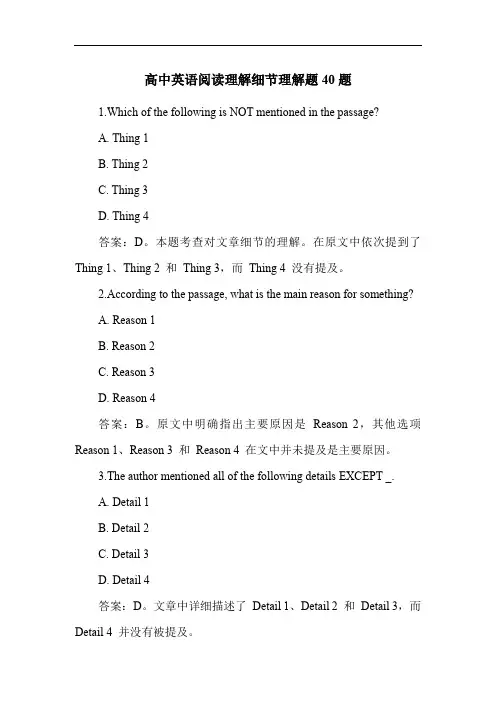
高中英语阅读理解细节理解题40题1.Which of the following is NOT mentioned in the passage?A. Thing 1B. Thing 2C. Thing 3D. Thing 4答案:D。
本题考查对文章细节的理解。
在原文中依次提到了Thing 1、Thing 2 和Thing 3,而Thing 4 没有提及。
2.According to the passage, what is the main reason for something?A. Reason 1B. Reason 2C. Reason 3D. Reason 4答案:B。
原文中明确指出主要原因是Reason 2,其他选项Reason 1、Reason 3 和Reason 4 在文中并未提及是主要原因。
3.The author mentioned all of the following details EXCEPT _.A. Detail 1B. Detail 2C. Detail 3D. Detail 4答案:D。
文章中详细描述了Detail 1、Detail 2 和Detail 3,而Detail 4 并没有被提及。
4.What can we know from the passage about a certain person?A. Fact 1B. Fact 2C. Fact 3D. Fact 4答案:C。
根据文章内容,关于这个人我们可以知道Fact 3,而Fact 1、Fact 2 和Fact 4 与文章内容不符。
5.Which statement is TRUE according to the passage?A. Statement 1 is true.B. Statement 2 is true.C. Statement 3 is true.D. Statement 4 is true.答案:B。

阅读理解之“细节理解”题解题指导细节理解题是指原文提到了某事实、现象或理论,而题干则针对原文的具体叙述设问,属于浅层次的理解题,难度较低,但在中考中却占有很大比重。
同学们解答细节题时,需要在有限的时间内运用略读、扫读、跳读等技巧快速阅读,发现文章中的细节信息,然后遵循由整体到细节的原则,把握作者的思路,按全文—段落—词语的步骤来解题。
一、命题特点事实细节题的考点非常明确,考点通常集中在以下几处:1.列举信息。
文章中first, second, to begin with, in addition, on one hand, on the other hand等并列关系出现的地方,常会要求考生从所列的内容中选择符合题干要求的选项。
2.举例与打比方。
要注意那些引出例子或比喻的标志词,如as, such as, for example, for instance 等,用于引出具体事实,使文章观点更具说服力。
这些事例就是常考的细节之处。
3.指示代词出现。
这类考题常用来考查学生是否真正了解上下文句子之间的逻辑关系。
4.引用人物论断。
作者为使论点更有依据,常会引用某些权威人士的论断或采纳其重要的发现。
5.特殊标点符号后的内容。
因为特殊标点符号后的内容往往是对前面内容的进一步解释或说明,因此,注意到这些标点,也就注意到了细节。
这些特殊符号包括表示解释的破折号、括号和冒号以及表示引用的引号等。
另外,细节理解题的选项也很有特点:通常正确答案不是照搬的原文。
而干扰选项则正好相反,有的来自原文信息,但不是题目要求的内容;有的符合常识,但不符合原文内容;有的与原句内容极为相似,是在程度上有些变动;有的与原文大相径庭甚至完全相反;也有的是部分正确或部分错误。
二、解题方法1.跳读查找法。
这个方法的要点在于先看题干,然后带着问题读文章。
以what, who, where, when, why, how 提问的问题,可以从文章中直接找到答案。
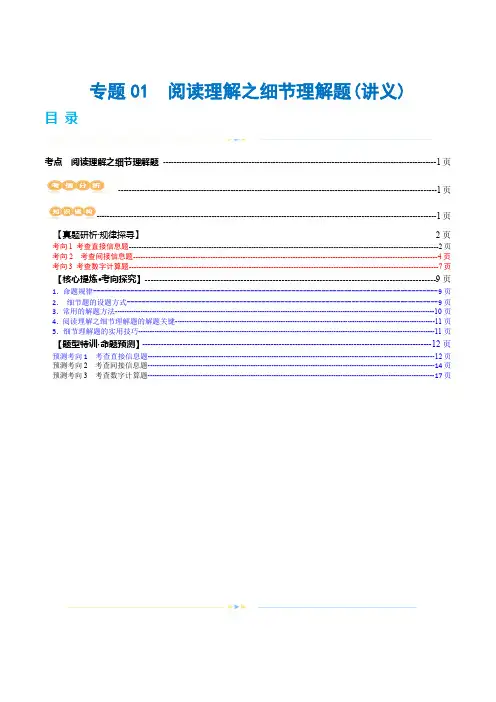
专题01 阅读理解之细节理解题(讲义)目录考点阅读理解之细节理解题------------------------------------------------------------------------------------------------------1页-----------------------------------------------------------------------------------------------------------------------1页-------------------------------------------------------------------------------------------------------------------------------1页【真题研析·规律探寻】-----------------------------------------------------------------------------------------------------2页考向1 考查直接信息题----------------------------------------------------------------------------------------------------------------------------2页考向2 考查间接信息题--------------------------------------------------------------------------------------------------------------------------4页考向3 考查数字计算题----------------------------------------------------------------------------------------------------------------------------7页【核心提炼·考向探究】----------------------------------------------------------------------------------------------------9页1.命题规律--------------------------------------------------------------------------------------------9页2.细节题的设题方式-----------------------------------------------------------------------------------9页3.常用的解题方法-------------------------------------------------------------------------------------------------------------------------------------------10页4.阅读理解之细节理解题的解题关键-----------------------------------------------------------------------------------------------------------------11页5.细节理解题的实用技巧---------------------------------------------------------------------------------------------------------------------------------11页【题型特训·命题预测】------------------------------------------------------------------------------------------------------------12页预测考向1 考查直接信息题-----------------------------------------------------------------------------------------------------------------------------12页预测考向2 考查间接信息题-----------------------------------------------------------------------------------------------------------------------------14页预测考向3 考查数字计算题-----------------------------------------------------------------------------------------------------------------------------17页考点 阅读理解之细节理解题考情分析:分析2021-2023年新高考阅读理解细节理解题考向分布。
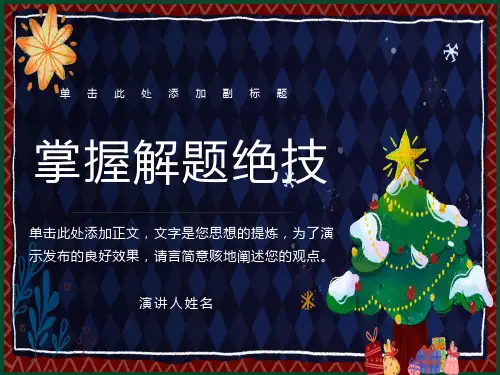
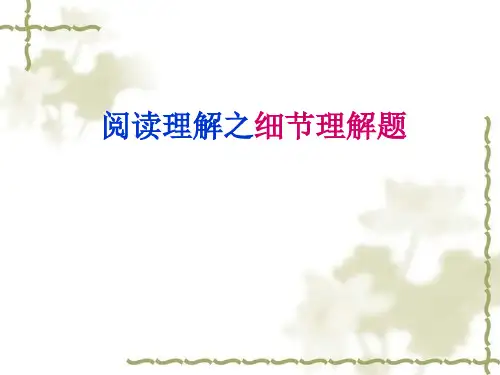
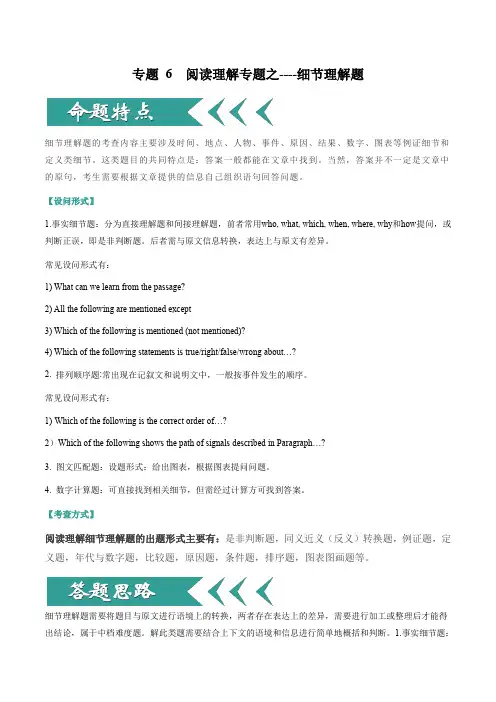
专题 6 阅读理解专题之----细节理解题细节理解题的考查内容主要涉及时间、地点、人物、事件、原因、结果、数字、图表等例证细节和定义类细节。
这类题目的共同特点是:答案一般都能在文章中找到。
当然,答案并不一定是文章中的原句,考生需要根据文章提供的信息自己组织语句回答问题。
【设问形式】1.事实细节题:分为直接理解题和间接理解题,前者常用who, what, which, when, where, why和how提问,或判断正误,即是非判断题。
后者需与原文信息转换,表达上与原文有差异。
常见设问形式有:1) What can we learn from the passage?2) All the following are mentioned except3) Which of the following is mentioned (not mentioned)?4) Which of the following statements is true/right/false/wrong about…?2. 排列顺序题:常出现在记叙文和说明文中,一般按事件发生的顺序。
常见设问形式有:1)Wh ich of the following is the correct order of…?2)Which of the following shows the path of signals described in Paragraph…?3. 图文匹配题:设题形式:给出图表,根据图表提问问题。
4. 数字计算题:可直接找到相关细节,但需经过计算方可找到答案。
【考查方式】阅读理解细节理解题的出题形式主要有:是非判断题,同义近义(反义)转换题,例证题,定义题,年代与数字题,比较题,原因题,条件题,排序题,图表图画题等。
细节理解题需要将题目与原文进行语境上的转换,两者存在表达上的差异,需要进行加工或整理后才能得出结论,属于中档难度题。
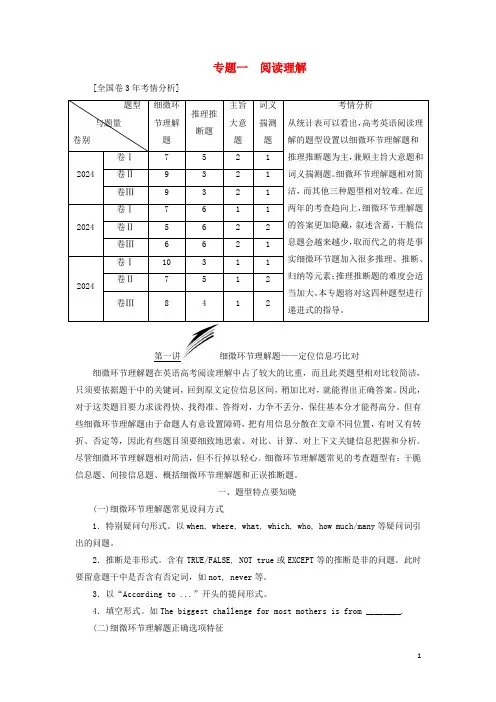
专题一阅读理解[全国卷3年考情分析]题型与题量卷别细微环节理解题推理推断题主旨大意题词义揣测题考情分析从统计表可以看出,高考英语阅读理解的题型设置以细微环节理解题和推理推断题为主,兼顾主旨大意题和词义揣测题。
细微环节理解题相对简洁,而其他三种题型相对较难。
在近两年的考查趋向上,细微环节理解题的答案更加隐藏,叙述含蓄,干脆信息题会越来越少,取而代之的将是事实细微环节题加入很多推理、推断、归纳等元素;推理推断题的难度会适当加大。
本专题将对这四种题型进行递进式的指导。
2024 卷Ⅰ7 5 2 1 卷Ⅱ9 3 2 1 卷Ⅲ9 3 2 12024 卷Ⅰ7 6 1 1 卷Ⅱ 5 6 2 2 卷Ⅲ 6 6 2 12024 卷Ⅰ10 3 1 1卷Ⅱ7 5 1 2卷Ⅲ8 4 1 2第一讲细微环节理解题——定位信息巧比对细微环节理解题在英语高考阅读理解中占了较大的比重,而且此类题型相对比较简洁,只须要依据题干中的关键词,回到原文定位信息区间,稍加比对,就能得出正确答案。
因此,对于这类题目要力求读得快、找得准、答得对,力争不丢分,保住基本分才能得高分。
但有些细微环节理解题由于命题人有意设置障碍,把有用信息分散在文章不同位置,有时又有转折、否定等,因此有些题目须要细致地思索、对比、计算、对上下文关键信息把握和分析。
尽管细微环节理解题相对简洁,但不行掉以轻心。
细微环节理解题常见的考查题型有:干脆信息题、间接信息题、概括细微环节理解题和正误推断题。
一、题型特点要知晓(一)细微环节理解题常见设问方式1.特别疑问句形式。
以when, where, what, which, who, how much/many等疑问词引出的问题。
2.推断是非形式。
含有TRUE/FALSE, NOT true或EXCEPT等的推断是非的问题。
此时要留意题干中是否含有否定词,如not, never等。
3.以“According to ...”开头的提问形式。

细节理解题(一)题干定位(2015·全国Ⅰ,A)Monthly Talks at London Canal MuseumOur monthly talks start at 19:30 on the first Thursday of each month except August.Admission is at normal charges and you don't need to book.They end around 21:00.November 7thThe Canal Pioneers,by Chris Lewis.James Brindley is recognized as one of the leading early canal engineers.He was also a major player in training others in the art of canal planning and building.Chris Lewis will explain how Brindley made such a positive contribution to the education of that group of early “civil engineers”.December 5thIce for the Metropolis,by Malcolm Tucker.Well before the arrival of freezers,there was a demand for ice for food preservation and catering.Malcolm will explain the history of importing natural ice and the technology of building ice wells,and how London's ice trade grew.February 6thAn Update on the Cotswold Canals,by Liz Payne.The Stroudwater Canal is moving towards reopening.The Thames and Severn Canal will take a little longer.We will have a report on the present state of play.March_6thEyots and Aits—Thames Islands,by Miranda Vickers.The Thames has many islands.Miranda has undertaken a review of all of them.She will tell us about those of greatest interest.Online bookings:/bookMore info:/whatsonLondon Canal Museum1213 New Wharf Road,London NI 9RT www.canalmuseum.mobiTel:020 7713 0836文章大意:本文是一则关于伦敦运河博物馆月度讲座安排的广告。
阅读理解(一)------细节理解题解题技能细节理解题要求考生对阅读材料中的某一具体事实和细节进行理解。
它们大都是根据文章中的具体信息如事实、例证、原因、过程、论述等进行提问的。
有些问题可以在文章中直接找到答案,有些则需要我们在理解的基础上将有关内容系统化才能找到,比如计算、排序、是非判断、图形比较等。
常见的命题方式通常有:1.特殊疑问句形式。
以when, where, what, which, who, how much/many等疑问词开头引出的问题;2. 以是非题的形式。
true /false, not true / false或EXCEPT;3. 以According to…开头提问方式;4. 以填空题的形式,如:(1)To avoid attracting mountain lions, people are advised .(2)By the first sentence of the passage author means that .(3)It seems that now a country’s economy depends much on .(4)If you are interested in knowing about what people’s life will be, you may visit .(5)The policemen were told ―to look the other way‖ (the underlined part in Paragraph 2) so that .(6)The poli ceman who said ―Good evening‖ to Rolls wanted to. 等等5. 就文中数字、排序、识图等提问。
做细节理解题时,大多数学生易出现的问题是阅读速度太慢,缺乏一定的快速阅读技巧,考生要培养自己快速获取信息的能力。
高中英语阅读理解事实细节题篇一:高一英语阅读理解事实细节专练高一英语阅读理解.一. 理解事实细节.(1)A doctor was once teaching a class of medical students at a famous hospital in Edinburgh. An injured man was brought in, and the doctor turned to one of the students and asked him, ―What‘s wrong with this man?‖― I don‘t know, sir ― the student answered. ― Shall I examine him and find out?‖― There‘s no need to examine him‖, said the doctor, ―You should know without asking questions. He has hurt his right knee. Didn‘t you notice the way he walked ? He hurt it by burning it in the fire. You see his trouser leg is burnt away at the knee. This is Monday morning. Yesterday was fine, but on Saturday the roads were wet and muddy. The man‘s trousers are muddy all over. The man fell down on Saturday night.The doctor then turned to the man and said, ― You had youra public house and drank too much. You got wet and muddy on the way home. Because you had drunk too much, you fell on the fire and burnt your knee. Is thatright ?‖―Yes, sir.‖ said the man.1. The medical students were having a lesson______________.A. in a classroomB. at the libraryC. at a well-known hospitalD. a medical school2. The man hurt his knee_______________.A. on Saturday nightB. yesterdayC. on Monday morningD. on Friday night3. The man burnt his knee _______________.A. when he was on his way to the hospitalB. because he had drank too much and fell on the fireC. because he was coldD. because he was ill4. WAGE in the fourth paragraph means_______________.A. holidayB. money paid every weekC. carsD. servants5. The doctor was good at _______________.A. learning from othersB. taking care of othersC. watching and thinkingD. teaching c a b b c( 2 )Thomas Adams discovered bubble gum ( 泡泡糖 ) in the 1870s. He was an American. He wanted to find a usefor chicle(糖胶树胶). Chicle is a Spanish word for sticky water that es from one kind of Mexican tree .Mr Adams wanted to make rubber from chicle.Mr Adams worked in his home while he tried to find a way to make the chicle stronger. Hisson, Horatio, also helped him now and then.One day, young Horatio began to chew the chicle while he watched his father work. It did not taste very good, but Horatio enjoyed chewing it. Then the young boy began to blow bubbles with the new chicle which his father had made. Mr Adams had discovered bubble gum by accident.Mr Adams gave up trying to find a way to make rubber from chicle. Instead , he wanted to try and sell the new gum that he had made. He thought other peoplemight like the taste too. He began to see his new kind of chicle as candy. In no time, children everywhere began chewing bubble gum.1. Where was Thomas Adams from ?A. CanadaB. The United StatesC. EuropeD. England2. Who was Horatio Adams?A. Thomas's fatherB. Thomas's wifeC. Thomas's brotherD. Thomas's son3. What was Thomas Adams trying to make ?A. A new kind of rubber .B. A new kind of chicle.C. A new kind of candy.D. Electric light.4. Why did Thomas Adams want to sell bubble gum ?A. His son enjoyed chewing it .B. He thought many people would like it.C. He could not make strong rubber from chicle.D. all of above5. Which of these sentences is not true?A. Horatio helped his father.B. Thomas Adams made rubber from chicle by accident.C. Horatio was the first person to chew bubble gum.D. Thomas Adams never made rubber. Bdadb(3)You can see a bell tower that leans (倾斜 ) in the town of Pisa, Italy. What does it lean against ? Nothing. It's called the Leaning Tower of Pisa, andit's been leaning more ever since it was built about 700 years ago. Some say that long ago the great Italian scientist Galileo dropped weights from the tower to learn how fast things fall. Even then , the tower was a leaning tower.And today , little by little, one side of the tower keeps on sinking into the soft ground. The LeaningTower tips (倾斜 ) about an inch every nine years. The farther it leans out of line, the faster it tips.You can climb stairs to the top of the tower and see the bells that once called people to a nearby church. But no one rings the bell now. The clang(铿锵声 ) might make the tower fall faster.The government of Italy once offered a prize for the best plan to keep the tower from falling any farther. Some people have ideas, but nothing has been done yet. If the Leaning Tower ever falls, it will be the end of what some people say is one of the seven wonders of the modern world.1. The Leaning Tower ___________.A. because famous right after it was builtB. leans against towerC. was built about seven centuries agoD. no longer tips today2. What do you know about Galileo?A. He was a great physicist who built the Tower.B. He was well known for designing the Tower.C. He drew a very famous experiment on the Tower.D. He designed a good plan to adjust the Tower.3. Nobody rings the bells in the Tower nowbecause_______________.A. there is something wrong with the bellsB. people in the town are annoyed by the ringing bells.C. nobody needs to be called to the churchD. the clang might make the Tower tip faster4. Which of the followings is NOT mentioned in the passage?A. The reason why the Leaning Tower is leaning.B. The condition of the Leaning TowerC. The plans that people offer to prevent the Tower from leaning.D. The measures that the government has taken to keep the Tower from falling.5. We can learn from the passage that _______________.A. people like the Leaning Tower so they have done nothing to keep it from leaningB. it is very difficult to stop the tower from leaningC. even if the Tower falls , the seven wonders will still existD.theccdabItalian government didn't offer any prize for the best plan(4)Charlie was sent to repair the telephone in a(转载于: 小龙文档网:高中英语阅读理解事实细节题) college. He stopped his car outside the gate and walked through a wide boulevard while a professor and his students were standing around the college flagpole in front of the teaching building. He stopped to watch what they were doing there." We need to know how high the flagpole is," said the professor to his students ." Who has a better way to calculate it ?"them all. Charlie began to laugh and came up to the flagpole .'"Watch!" said the young man. He laid the flagpole on the ground and measured it with a tape and then said, " Exactly 15.12 meters." Then he replaced the pole and walked away." What a silly idea!" the professor said angrily ." We wonder how height it is. But he gave us the length!"1. Charlie was a _____________.A. teacherB. professorC. repair manD. postman2. Charlie went to the college____________.A. by busB. on footC. by bikeD. by car3. The professor was going to ___________.A. put the flagpole downB. teach his students to calculate the flagpole's heightC. make a new flagpoleD. show his students how to measure the flagpole4. The underlined word "negated" means___________.A. encourageB. not agreeC. praiseD. know5.Charlie laughed because____________.A. he was good with mathB. he thought the professor was sillyC. he could easily know the flagpole's heightD.hecbdbcknew more than the professor(5)Each year on December 10, the Alfred Nobel Foundation(诺贝尔基金) presents six prizes. These prizes are named after Alfred Nobel, the man who invented dynamite(火药). It was Mr Nobel ?s idea to create(创造)the prizes. During his life, Mr Nobel made a lot of money from his invention. He put his money in a bank, and the money earned more money through interest(利息) from the bank. The money grew to be a very large amount.Mr Nobel decided to use his money to help scientists, artists, and people who worked to help others around the world. He created the Nobel Prizes to do this.The prizes set up by Mr Noble include physics, medicine, chemistry, literature, and peace.These five Nobel Prizes were first given out in 1901. Later, the Central Bank of Sweden(瑞典) made the Alfred Nobel Memorial Prize in Economic(经济) Science in1968 to celebrate(庆祝) the bank‘s 300th year of business.All of the prizes are handed out in Stockholm(斯德哥尔摩) except for the Peace Prize, which is presented in Oslo(奥斯陆).Each person who receives a Nobel Prize is given a cash prize, a medal, and a special paper which explains the prize the person won. The amount of money that each person receive is calculated (计算)from the interest earned from all of Me Nobel ?s money which is still in the bank.. This interest is divided equally betweenthe five prize winners in physics, medicine, chemistry, literature, and peace. The Central Bank of Sweden then pays an equal amount to the winner of the prize in Economics.1. The Nobel Prizes are presented ________A. at different timeB. In DecemberC. Every two yearsD. Every six years2. The main idea of the second paragraph is _____A. how many prizes Mr Nobel set upB. why Nobel Prize was createdC. what each prize winner will receiveD. where the prizes were presented3. Mr Nobel set up ______prizes at first.A. 5B. 6C. 7D. we don‘t know4. The Nobel Prize of ______are made and paid by Central Bank of Sweden.A. EconomicsB. MedicineC. LiteratureD. Physics5. The winners of the Nobel Prize will receive these except_______A. A medalB. MoneyC. An inventionD. A special paperKeys are : B B A A C篇二:高中英语阅读理解方法之细节题的解题技巧英语阅读理解---事实细节题的解题技巧所谓细节题,是指原文提到了某事物、现象或理论,题干针对原文具体叙述本身发问。
中考英语阅读理解设题及解答技巧中考英语阅读理解设题主要分成细节理解题、词义猜测题、推理引申题和主旨大意题,尤其是主旨大意题,初中学生普遍感觉复习没有方向,掌握不了技巧。
本文旨在对各个设题进行剖析,和学生共同揣摩解题方法,掌握技巧,化解压力。
一,阅读理解之细节理解题1. 细节题即我们常见的wh-题,(what, which, who, where, why, when, whose, how),根据文章的具体信息如事实,例证,原因,过程等进行提问,考查学生获取信息,以及对文章所提供信息的理解能力。
2. 常见设题方式(1) Which of the following statement is True/ Not True?(是非判断题型)(2) Which of the following is Not mentioned in the text?(3) What/ Who/ When/ Where/ Why/ How…?(特殊疑问类型)(4) All the statements are true Except?(except,除……之外)(5) Which is the right order of …?(排序题类型)(6) The au thor gives in the example in …paragraph in order to …(例证题类型)(7) …the most/ ~est; ……the only ……(判断修饰限定的细节题类型)3. 答题技巧(1) 审题:找出题干或选项中的关键词(数字,大写,人民,地名等);(2) 阅读全文,确定该细节在文中的出处;(3) 对照题干要求,排除或者选择;(4) 确定答案,并验证答案。
例题1:How much does your mother do for you? She taught you to walk, helped you learn to read and looks after you every day. And you could never thank her enough for everything.Q: According to the passage, what did your mother do for you?A. Taught you to walk. C. Took care of youB. Helped you learn to read D. All of the above.答案:D,根据划线部分可知A,B,C都是,故选择D。